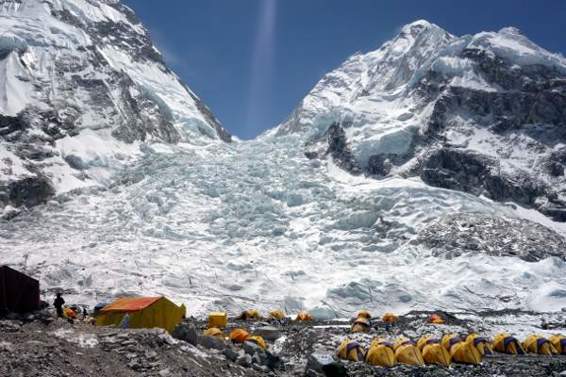
Thursday, 17 April 2014 – Everest Base Camp, Nepal

Phil is still here at breakfast this morning. He didn’t join the Sherpas on their latest carry to Camp 2, to assess the route, but he now has an alternative plan for the Icefall. He suggests we all make a short one- to two-hour foray up into the ice tomorrow to keep us from going stir crazy.
There’s some logic to this. It sounds like the route will not be ready for a few days, and we’ve been here at Base Camp for several days now without much action. Lethargy is settling in. If we can’t go higher yet, then a brief spell in the Icefall will help to keep us interested.
It’s cold and windy after breakfast. Instead of joining some of the others for another walk down to Gorak Shep, I decide to go up the valley for my first look at the rest of Everest Base Camp. Our tents are at the bottom end. Since we arrived I’ve been no higher, and I’m keen to get a better sense of what Base Camp is like.
Our camp – and those of our neighbours, Himex and International Mountain Guides (IMG) – turns out to be in an outlying village. I pass through a grey belt of glacier before reaching the rest of camp.
Base Camp is long and sprawling. It takes me about forty minutes to walk from one end to the other at my slow, ambling pace. I discover that it’s far from being the shanty town of tents often portrayed. Everywhere I look tents nestle in folds of moraine or perch on ridges, but there is plenty of space for everyone. The area could easily accommodate twice as many tents without difficulty.
Eventually I reach the camp of a big Indian team at the far end, and find myself staring right up the Icefall between the West Shoulder and Nuptse. I see figures coming down between walls of seracs. It doesn’t look quite so intimidating from here.
For many years I have dreamed about this place. The Khumbu Icefall is one of Everest’s most famous (and infamous) features. I’ve been to the summit from the north side, but this is the first time I’ve looked up the crumpled heap of broken ice that stretches into the far distance.
The immensity of this ice sheet, hundreds of metres thick, is difficult to comprehend. Within its folds are crevasses so vast they would swallow an ocean liner many times over. Some of these chasms are hidden by tiny cracks that entirely disappear under newly fallen snow. Rising above them are towers of leaning ice that would dwarf many skyscrapers, ready to topple with a slight movement of the glacier or warming of the sun, and there is no hope of survival if you are passing underneath. A party of climbers roped together would be crushed as easily as ants beneath a hobnailed boot.

A majestic-looking Khumbu Icefall from Everest Base Camp
I’m well aware of its fearsome reputation, and the people who have lost their lives within its towering corridors. The first was Jake Breitenbach, a young American climber who was forging a route through the Icefall in 1963. A large section of ice collapsed with a roar. He was roped to two other climbers, who survived the accident with the help of teammates who came to their aid. The rescuers could see no trace of Breitenbach. The rope led down into many tons of giant ice blocks. He must have been killed instantly.
In the last fifty years there have been thirty more deaths here, either from collapsing ice, avalanches or falls into crevasses. The overwhelming majority of victims have been Sherpas, who spend so much more time exposed to danger as they carry heavy loads up and down the mountain.
I’m aware of all these things, but I also know there are few places like it anywhere. It can only be seen to be believed. I’m relishing the opportunity to explore further, and looking forward to our little foray tomorrow.